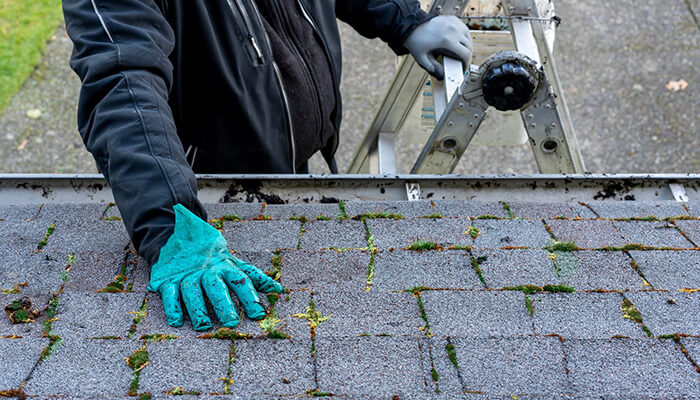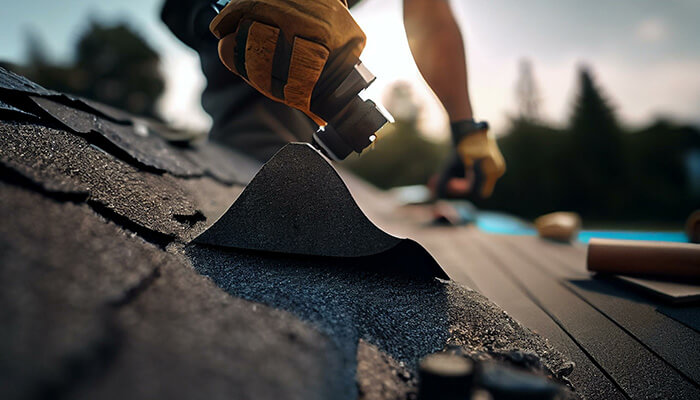Imagine waking up one morning, and instead of the bright sunlight streaming through your windows, you see a dark stain spreading across your ceiling. This unwelcome sight could be a direct result of neglecting your home’s protective shield – the roof.
Understanding the dual role of roof maintenance is crucial. It goes beyond being a necessary chore – it’s an investment that enhances your home’s longevity and value. In the following sections, we probe into the specifics of roof shingle maintenance, and discuss how you can prevent damage and extend their lifespan.
Understanding Your Roof: All About Shingles
A critical part of maintaining your roof involves understanding its main components, one of which is the shingles. These vital elements shield your home from harsh weather conditions, with different types offering varying degrees of protection and lifespan. As we look into the specifics, we’ll cover:
- Material: The substance from which they are crafted significantly influences their longevity.
- Lifespan: The lifespan largely depends on their type. For instance, asphalt shingles generally last about 20 years, while metal can protect your home for up to 70 years.
- Role: Shingles are a pivotal part of your home’s defense system against the elements. They’re designed to shed water and shield the underlying structure from the impact of sun, wind, rain, and snow.
Armed with this knowledge, you can take the necessary steps to maximize the lifespan of the roofing material. This way, you can prevent premature wear that could lead to needing a shingle roof replacement in Madison Wisconsin. With this knowledge of shingles in mind, let’s examine how to identify signs of damage promptly.
Spotting The Signs: Recognizing Shingle Damage
Roof shingles, the first line of defense against the elements, can display various signs of damage over time. Understanding these symptoms allows for early intervention and maintenance. Here’s what to watch out for:
- Curling: Consistent weather changes can cause them to curl at the edges, which if left untreated, can lead to leaks.
- Cracking: Spotted any cracked or broken shingles? They’re clear signs of wear and tear and, if ignored, can pave the way for leaks and subsequent water damage.
- Loss Of Granules: If you’re finding granule particles in your gutters, it’s likely they’ve worn off your shingles, indicating their diminishing effectiveness.
- Discoloration: Discoloration can be a sign of mold or algae growth, which can damage the material over time.
- Bald Spots: Bald spots where granules are missing can indicate that your roof is nearing the end of its lifespan.
Stay alert to these signs to prevent further deterioration. Let’s move on to maintaining your roof regularly to prolong its life.
Preserving Your Roof: Regular Maintenance Tasks
To keep your roof in optimum condition, it’s crucial to incorporate regular maintenance tasks into your routine. The following are essential steps to maintain your roof’s health:
- Clean Your Gutters: Keeping your gutters free from debris prevents water from pooling onto your roof, thereby avoiding water damage.
- Remove Roof Debris: Leaves, branches, and other debris on your roof can trap moisture and lead to decay. Regular cleaning helps avoid this.
- Inspect For Damage: Routinely inspect your roof for any signs of damage, such as cracked or missing shingles, which need prompt attention.
- Check the Attic: Inspecting your attic regularly can help detect leaks, poor ventilation, and insulation issues.
- Keep An Eye On Roof Valleys: The valleys, common places for leaks to occur, should be regularly monitored and kept clear of debris.
By incorporating these tasks into your routine, you can effectively preserve your roof. Next, let’s look at some minor repairs you can handle yourself.
Simple Home Maintenance: Handling Minor Repairs
Certain minor roof repairs are within the reach of most homeowners. Here are a few you can undertake to maintain your roof:
- Replacing Damaged Shingles: If a few sections are damaged, you can replace them yourself to prevent water penetration.
- Applying Roof Sealant: Applying a sealant can address minor leaks and protect them from weathering.
- Repair Loose Shingles: A loose shingle can be nailed back into place to prevent it from getting torn off during a storm.
- Maintain Roof Caulking: Check and maintain the caulking around roof installations like chimneys or vents.
Remember, safety comes first. Now let’s explore when you should call in the professionals.
Professional Help: When To Call In The Experts
While DIY maintenance and repairs are effective, some situations call for expert intervention. Consider professional from Texas Choice help when you notice:
- Large Cracks: Large, extensive cracks are beyond the scope of DIY and require professional repair.
- Sagging Areas: A sagging roof is a serious concern and should be evaluated by a professional immediately.
- Extensive Moss Growth: Moss retains moisture, which can damage the roof. If moss covers a large area, professional cleaning is recommended.
- Multiple Leaks: Several leaks appearing at once can indicate more extensive damage and may require professional repair.
- Roof Age. If your roof is nearing the end of its typical lifespan (around 20-25 years for asphalt shingles, 30 years for wood, and up to 70 years for metal), it may be time to enlist a professional for a thorough inspection.
Knowing when to seek professional help can save your roof from significant damage. Finally, let’s discuss preventative measures to extend the life of your roof.
Proactive Measures: How to Extend Your Shingle’s Lifespan
To ensure your roof stands the test of time, certain preventative steps are key. Here are some strategies to consider, including the crucial yearly professional inspections:
- Proper Attic Ventilation: Ventilation prevents heat and moisture buildup, protecting them from premature aging.
- Regular Gutter Maintenance: Regular cleaning prevents water buildup, protecting your roof and extending their lifespan.
- Trim Overhanging Tree Branches: Trimming prevents branches from scratching your shingles and keeps leaves from accumulating on your roof.
- Roof Insulation: By regulating your attic’s temperature, proper insulation protects your roof from the damaging effects of extreme temperatures.
- Annual Inspections: Scheduling a yearly inspection with a roofer can help identify potential issues early on.
These preventative measures contribute to prolonging the life of your shingles, thereby maintaining the integrity of your roof.
Your Roof, Your Responsibility: Conclusion
In conclusion, the longevity of your roof and prevention of damage hinge on consistent maintenance, prompt detection of damage, timely minor repairs, discerning when professional help is needed, and carrying out preventative strategies. By adhering to these steps, you can ensure the robustness of your roof for years, thereby safeguarding your home.



